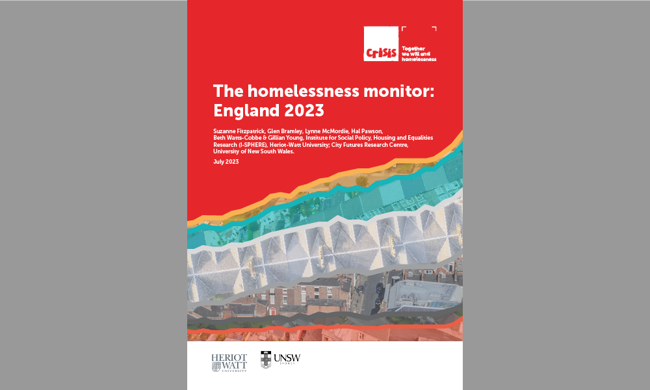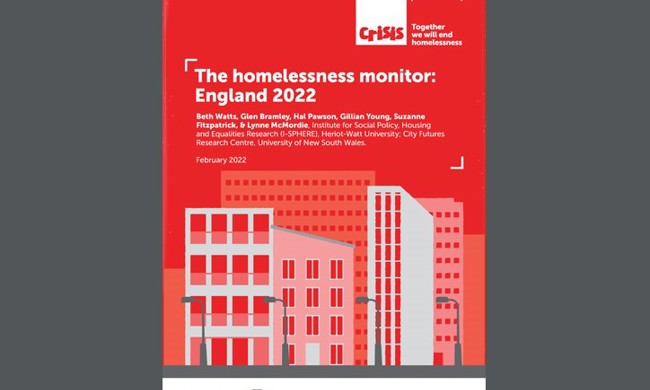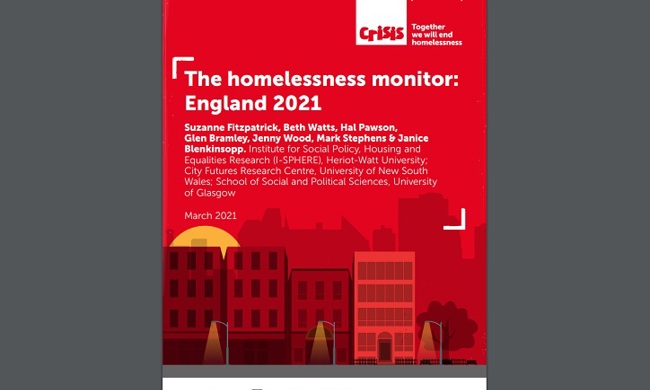The Homelessness Monitor: England 2023
18.08.2023
The Homelessness Monitor: England 2023 was commissioned by Crisis and led by Heriot-Watt University, as part of the Homelessness Monitor series, a longitudinal study providing independent analysis of the homelessness impacts of recent economic and policy developments in England. The research takes stock of homelessness in 2023 and the five year period before this. It also highlights emerging trends and forecasts some of the likely future changes, identifying the developments likely to have the most significant impacts on homelessness.
Key findings
These findings come from research methods including a survey of local authorities, interviews with key informants in the public and voluntary sectors, and a statistical modelling exercise that estimates levels of 'core' homelessness and projects trends in these forms of homelessness into the future.
- Some 290,000 eligible households sought help from local authorities on grounds of homelessness in 2021/22. While those judged at risk of homelessness within 56 days increased by 10% over the year, applicants assessed as actually homeless fell by 4%. Nonetheless a large majority of local authority survey respondents (85%) perceived that homelessness service ‘footfall’ had increased in the preceding year - the highest number to say this in any year since the Homelessness Monitor: England local authority survey began. 88% of councils reported an increase in requests for support from those evicted from the private rented sector while 93% anticipated a further increase over the coming year.
- Since bottoming out in 2010/11, total temporary accommodation placements had more than doubled to over 100,000 households by 31st December 2022. Within this, Bed and Breakfast hotel placements have risen more than five-fold since their 2009 nadir. Having increased sharply during the early part of the pandemic, Bed and Breakfast placements once again climbed steeply during 2022, up by 32% in the year to Q4 2022.
- Key informants reported that opportunities for upstream homelessness prevention are contracting because of sustained cuts to public services, a reduction in the supply of affordable rental properties, and a squeeze on household budgets. Deep cuts to Discretionary Housing Payments have further constrained the ability of local authorities to prevent homelessness.
- Following several years of decline, the number of people seen sleeping rough in England grew in 2022. At 3,069 in November of that year, recorded rough sleeping was 26% up on the equivalent figure twelve months earlier. London-specific data also indicates rising rough sleeping since 2021, with around half of those sleeping on the streets of the capital non-UK nationals, many of whom will have No Recourse to Public Funds or other restricted eligibility for statutory support.
- The launch of a refreshed Rough Sleeping Strategy in September 2022 was welcomed by key informants, particularly with regard to its confirmation of sustained investment in the Rough Sleeping Initiative. However, acute concerns remain about addressing rough sleeping amongst people with No Recourse to Public Funds or other restricted eligibility to statutory support, as pandemic-associated emergency accommodation options for this group have contracted sharply after the ending of specialist public health funding in April 2022.
- 'Core homelessness’ in England – a concept which captures the most acute forms of homelessness – is estimated to have totalled 242,000 in 2022, compared to 206,000 people affected a decade ago. This means that on a given night, 1 in 100 households in England are experiencing the worst forms of homelessness.
- Baseline forecasts show core homelessness rising significantly in the immediate future, with overall core homelessness in 2024 one fifth higher than 2020 levels. Current drivers of these increases relate primarily to inflation squeezing real incomes and increasing poverty and destitution, alongside rising private rents and evictions, and declining social rented lettings.
- In the shorter term, the most effective policies for reducing core homelessness would be allocation of a significant proportion of social lettings to core homeless households, increasing the level of the Local Housing Allowance, and maximising prevention activity to the level of the higher performing local authorities.
A full technical report outlining the core homelessness methodology has also been published here.
Reference
Fitzpatrick, S., Bramley, G., McMordie, L., Pawson, H., Watts-Cobbe, B., Young, G., (2023) The Homelessness Monitor: England 2023. London: Crisis.



